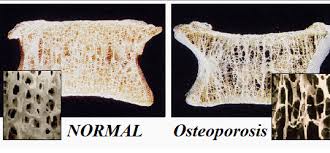Dowagers humps caused by bone loss
Dowagers humps: Frequently asked questions:
1. What is this? Where did the term originate?
If you have Osteoporosis of the spine, your vertebrae can fracture. This can cause Kyphosis or a Spinal hump.
These fractures sometimes happen 'spontaneously' but they happen most often when a person bends forward from the waist or leans or to the side to pick up something.
This is why competent physical therapy and yoga instructors tell their clients NEVER to bend from the waist - bend only from the hips. Try it. Stand. Now bend forward from your hips while keeping your spine straight. This is the way you should bend if you have osteopenia or osteoporosis. If you can not reach an item on the floor, squat or sit on a chair to pick it up. NEVER curve your spine when you bend.
Because so many women used to have untreated bone loss, and no one warned them about NOT letting their back arch when they bend forward, back humps (Kyphosis) became associated with older women.
Since the word dowager means a "dignified elder woman" and since many older women developed this sort of back hump, people began to call it 'dowager's hump' - even if the person with the kyphosis was a young woman or a man.
2. What is the process for developing Kyphosis or dowagers hump?
When your spinal vertebrae lose bone they become porous. They sometimes fracture spontaneously. This is most likely to happen if you bend forward from the waist, putting pressure on your spine. (In yoga, for example, practitioners are taught to ALWAYS bend from the hips- never from the waist. This keeps stress off spinal vertebrae.)

Also many people bend forward from their waist during the day - reaching for things, loading a dishwasher - they even sit curled in a chair while reading or watching television.
There are 3 types of spinal fractures that can occur in advanced osteoporosis.
- Wedge fracture - with this fracture the front of the vertebra collapses.
- Bioncave fracture - the midsection of the vertebra collapses.
- Crush fracture - the entire vertebra collapses. This type of fracture leads to lessening in overall height. You may notice that your health care provider measures your height at least once a year. They do this because a decrease in height can be an indication that your spine has had a crush fracture.
Dowagers humps (Kyphosis) are usually caused by wedge fractures.
In this kind of fracture the front of a vertebra collapses. Since the back of the vertebra remains intact, the vertebra 'tips' forward and the spine becomes slightly misaligned and the section above the fracture tips forward making the back curve slightly.
As the vertebrae above your wedge fracture 'tip forward' they
put stress on other vertebrae. This stress often causes another vertebra
to develop a 'wedge fracture'. As more and more vertebrae collapse in
wedge fractures, your back becomes more and more bowed.
Where in the spine do these fractures occur?
Spinal fractures, the kind that leads to dowagers humps, usually occur in the thoracic spine(in the area of your lungs) or the upper half of your lumbar spine. If you have advanced osteoporosis of the spine these fractures can occur when lifting something or even when sneezing or coughing.
Living with a dowagers hump...help is here
1. Avoid further fractures. You need to stop doing certain exercises if you have Osteoporosis of the spine.
See: Daily activities, exercises to avoid so as to avoid Dowagers humps
2. There are three medical interventions than can help:
b. A procedure called Kyphosis
c. A procedure called Vertebroplasty
3. There are some practical things that can help you feel better:
a. Getting a good mattress
b. Do Tai chi for balance, back strength and pain relief for your back
c. A special form of yoga exercise for kyphosis
d. Finding or making clothes that really fit so you look good
4. Plus there are many Natural treatments to reverse Osteoporosis and Osteopenia so your bones will grow stronger and your spine will not fracture further.
Do you have kyphosis (back hump)? What has helped you cope? If you can share some ideas with other readers, I am sure they would be grateful. Just use the form below.

